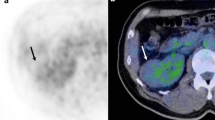Abstract
Purpose
Assessment of renal masses with conventional imaging may be challenging. Anti-1-amino-3-[18F]fluorocyclobutane-1-carboxylic acid (anti-[18F]FACBC) is a synthetic l-leucine analog with relatively little renal excretion. The present study examines anti-[18F]FACBC positron emission tomography uptake in patients with renal masses.
Procedures
Six patients with seven renal lesions were imaged dynamically for 2 h after injection of 10–10.9 mCi (370–403 MBq) anti-[18F]FACBC. Lesions were evaluated qualitatively and quantitatively and correlated with histology.
Results
Four clear cell and one Rosai–Dorfman lesion were hypo/isointense to normal cortex; two papillary lesions in the same patient were hyperintense. Mean SUVmax ± SD at 30 min was 2.8 ± 0.24 for clear cell carcinomas and 4.5 ± 1.7 for papillary cell lesions. Mean SUVmax/SUVmean ratios ± SD of lesion to normal cortex at 30 min was 1.15 ± 0.19 for the clear cell carcinomas and 2.3 ± 0.84 for papillary cell.
Conclusions
In this small patient sample, relative amino acid transport compared with renal cortex is elevated in renal papillary cell carcinoma but not in clear cell carcinoma.





Similar content being viewed by others
References
Jemal A, Siegel R, Ward E et al (2006) Cancer statistics, 2006. CA Cancer J Clin 56:106–130
Rodriguez R, Fishman EK, Marshall FF (1995) Differential diagnosis and evaluation of the incidentally discovered renal mass. Semin Urol Oncol 13:246–253
Montie JE (1991) The incidental renal mass. Management alternatives. Urol Clin North Am 18:427–436
Davidson AJ, Hartman DS, Choyke PL, Wagner BJ (1997) Radiologic assessment of renal masses: implications for patient care. Radiology 202:297–305
Kutikov A, Fossett LK, Ramchandani P et al (2006) Incidence of benign pathologic findings at partial nephrectomy for solitary renal mass presumed to be renal cell carcinoma on preoperative imaging. Urology 68:737–740
Bolton DM, Wong P, Lawrentschuk N (2007) Renal cell carcinoma: imaging and therapy. Curr Opin Urol 17:337–340
Zhang J, Lefkowitz RA, Ishill NM et al (2007) Solid renal cortical tumors: differentiation with CT. Radiology 244:494–504
Kang DE, White RL Jr, Zuger JH, Sasser HC, Teigland CM (2004) Clinical use of fluorodeoxyglucose F 18 positron emission tomography for detection of renal cell carcinoma. J Urol 171:1806–1809
Schuster DM, Votaw JR, Nieh PT et al (2007) Initial Experience with the radiotracer anti-1-amino-3-18F-fluorocyclobutane-1-carboxylic acid with PET/CT in prostate carcinoma. J Nucl Med 48:56–63
Martarello L, McConathy J, Camp VM et al (2002) Synthesis of syn- and anti-1-amino-3-[18F]fluoromethyl-cyclobutane-1-carboxylic acid (FMACBC), potential PET ligands for tumor detection. J Med Chem 45:2250–2259
McConathy J, Martarello L, Simpson NE et al (2002) Uptake profiles of six 18F-labeled amino acids for tumor imaging: comparison of in vitro and in vivo uptake of branched chain and cyclobutyl amino acids by 9LGliosarcoma tumor cells. J Nucl Med 43:41P
McConathy J, Voll RJ, Yu W, Crowe RJ, Goodman MM (2003) Improved synthesis of anti-[18F]FACBC: improved preparation of labeling precursor and automated radiosynthesis. Appl Radiat Isot 58:657–666
Nye JA, Schuster DM, Yu W, Camp VM, Goodman MM, Votaw JR (2007) Biodistribution and radiation dosimetry of the synthetic nonmetabolized amino acid analogue anti-18F-FACBC in humans. J Nucl Med 48:1017–1020
Oka S, Hattori R, Kurosaki F et al (2007) A preliminary study of anti-1-amino-3-18F-fluorocyclobutyl-1-carboxylic acid for the detection of prostate cancer. J Nucl Med 48:46–55
Schuster DM, Votaw JR, Halkar RK et al (2003) Uptake of the synthetic PET amino acid radiotracer 1-amino-3-[18F]fluorocyclobutane-1-carboxylic acid (18F-FACBC) within primary and metastic brain cancer compared with 18F-fluorodeoxyglucose (18F-FDG). J Nucl Med 5:167
Shoup TM, Olson J, Hoffman JM et al (1999) Synthesis and evaluation of [18F]1-amino-3-fluorocyclobutane-1-carboxylic acid to image brain tumors. J Nucl Med 40:331–338
Ruppert-Kohlmayr AJ, Uggowitzer M, Meissnitzer T, Ruppert G (2004) Differentiation of renal clear cell carcinoma and renal papillary carcinoma using quantitative CT enhancement parameters. AJR Am J Roentgenol 183:1387–1391
Acknowledgements
This research was sponsored by a Society of Nuclear Medicine Research and Education Foundation Pilot Research Grant. We would like to acknowledge the hard work of Fenton G. Ingram, CNMT, PET, RT(R) on this protocol as well as all our technologists at Emory Healthcare. We also gratefully acknowledge the contributions of Ron Crowe, R.Ph. for radiotracer synthesis, Dr. Mahul B. Amin for histologic interpretation, Dr. John Carew for statistical consultation, and Drs. Fray F. Marshall, Kenneth Ogan, and Chad Ritenour for clinical urologic guidance and patient referrals. Dr. Mark Goodman and Emory University are eligible to receive royalties from this radiotracer.
Author information
Authors and Affiliations
Corresponding author
Rights and permissions
About this article
Cite this article
Schuster, D.M., Nye, J.A., Nieh, P.T. et al. Initial Experience with the Radiotracer Anti-1-amino-3-[18F]Fluorocyclobutane-1-Carboxylic Acid (Anti-[18F]FACBC) with PET in Renal Carcinoma. Mol Imaging Biol 11, 434–438 (2009). https://doi.org/10.1007/s11307-009-0220-5
Received:
Revised:
Accepted:
Published:
Issue Date:
DOI: https://doi.org/10.1007/s11307-009-0220-5




